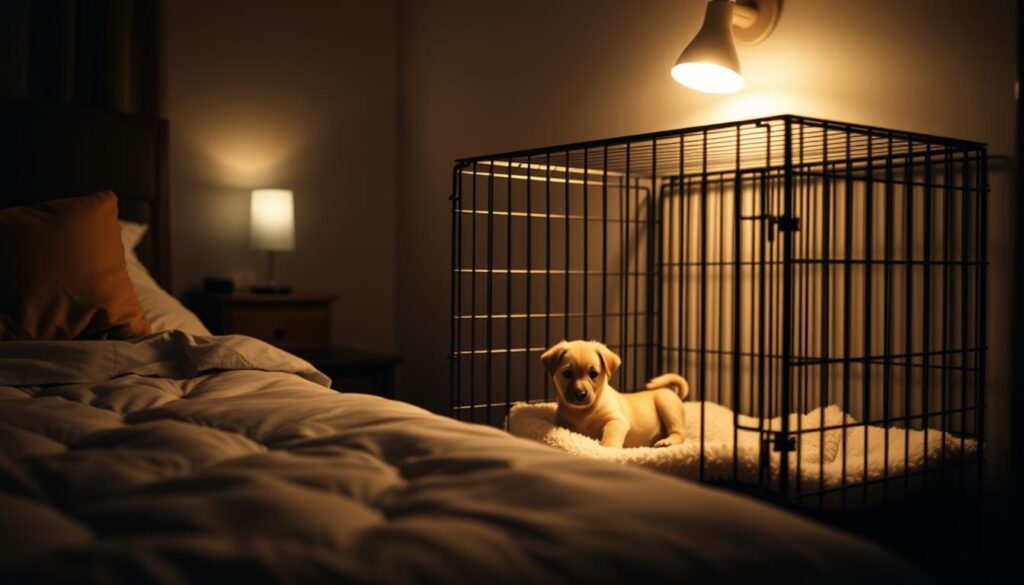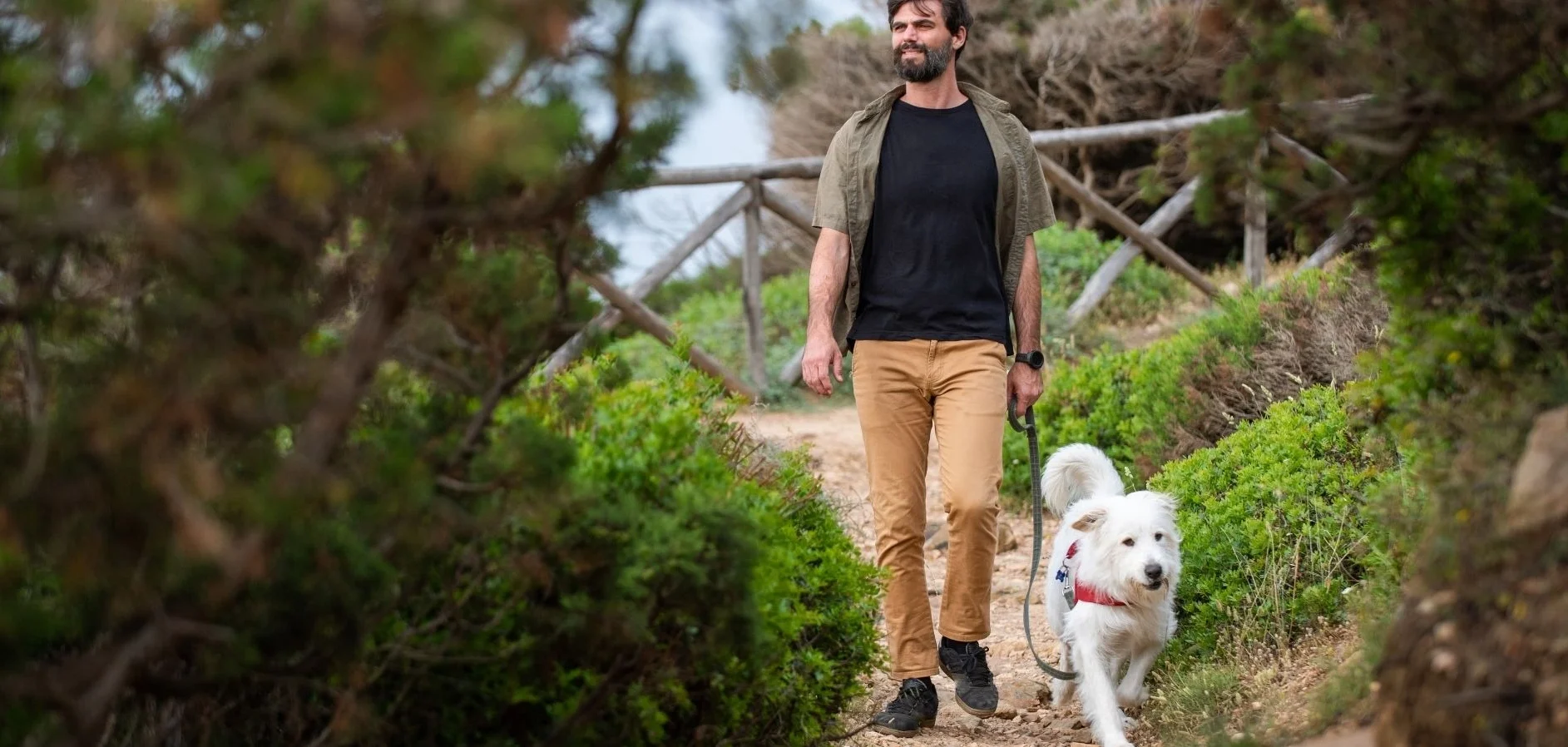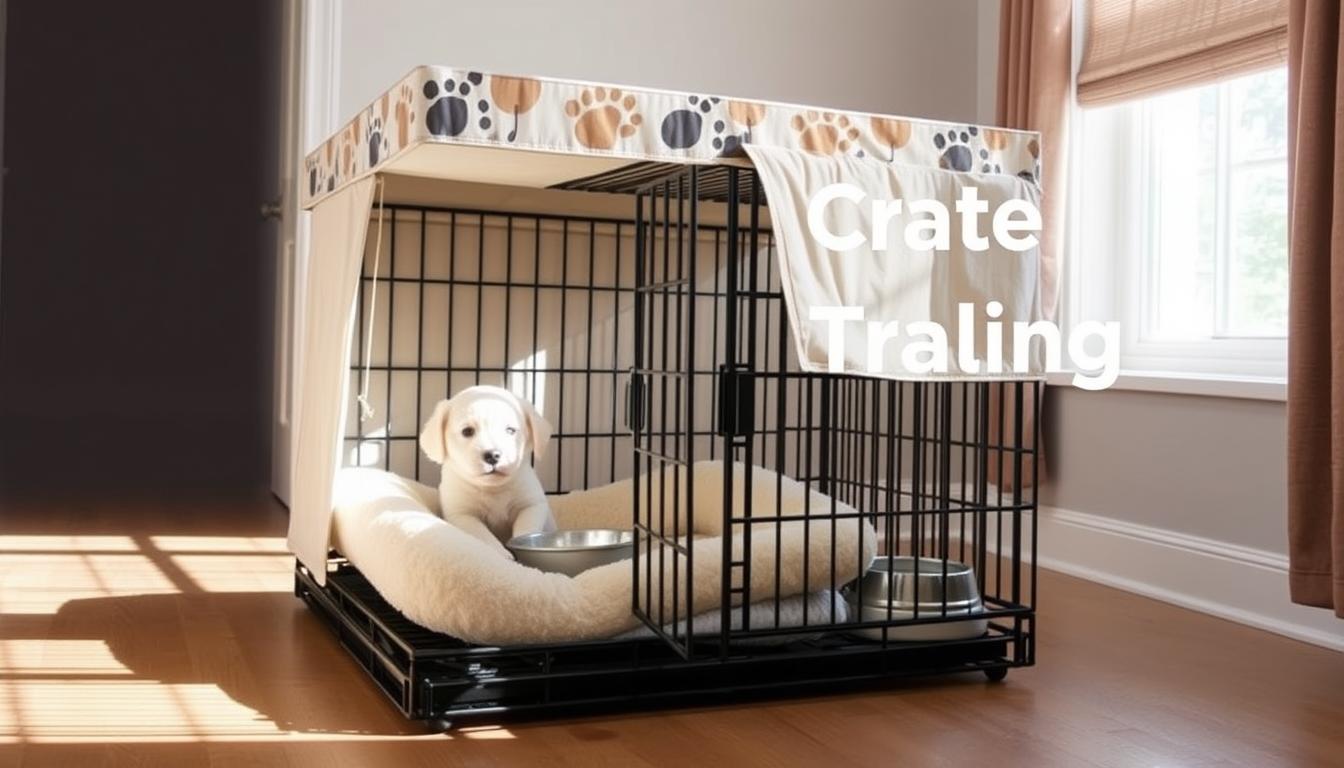Crate Training Puppies: Tips for Success at Any Age
Table of Contents
Crate training puppies is a challenge every puppy parent faces when finding a safe space for their furry friend. Crate training is more than just keeping them in a box. It’s about creating a cozy, secure area where your puppy feels safe and happy. This method works for puppies of all ages, from tiny eight-week-olds to older dogs.
Think of a crate as your puppy’s own special retreat. It’s a place of comfort during scary times and helps teach important life lessons. Crate training isn’t about punishment. It’s a kind way to teach your puppy about boundaries, safety, and growing up. Whether you’re new to dog ownership or have experience, learning crate training can change your bond with your puppy.
Key Takeaways
- Crate training provides a safe personal space for puppies
- Successful training works for puppies of all ages
- Creates positive behavioral foundations
- Helps with potty training and preventing destructive behaviors
- Reduces anxiety and promotes puppy security
Understanding the Fundamentals of Crate Training
Dog crate training is more than just keeping your pet in a small space. It’s about creating a safe, comfy spot that meets their natural needs. Learning the basics of crate training can make this process easier for both you and your dog.
Dogs are naturally den animals, seeking personal space like their wild ancestors did. When you introduce a crate correctly, you’re giving them a modern version of their ancestral den.
What is Crate Training?
Crate training teaches your dog to see their crate as a safe, personal space. It aims to make the crate a positive place where your dog feels safe and relaxed. Important parts include:
- Creating a personal sanctuary for your dog
- Establishing a sense of security
- Providing a defined space for rest and relaxation
Why Dogs Need Their Personal Space
Your dog’s need for personal space is deep-rooted. Crate training techniques support this natural behavior. Just like humans, dogs also appreciate having their own space.
The Psychology Behind Den Behavior
Wild canines seek small, enclosed spaces for safety and comfort. Domestic dogs still have this instinct. A well-designed crate provides a sense of security, helping to reduce your dog’s anxiety and stress.
“A crate is not a cage, but a den – a safe haven for your dog.” – Professional Dog Trainer
Essential Benefits of Puppy Crate Training
Crate training puppies has many benefits beyond just keeping them in one place. It helps your puppy grow into a well-adjusted and confident dog. It gives them a safe space to feel secure and learn important lessons.
The main advantages of crate training are:
- Effective housebreaking support
- Preventing destructive behaviors
- Creating a safe personal space
- Emergency preparedness
Puppies like to have their own cozy spots. Crate training meets this need, making them feel safe and calm. It helps them see their crate as a place to relax and feel secure.
| Benefit | Description |
|---|---|
| Housetraining | Supports consistent bathroom habits and reduces accidents |
| Safety | Prevents potential household hazards when unsupervised |
| Travel Readiness | Prepares dogs for veterinary stays and emergency situations |
When crate training puppies, be patient and use positive methods. Your puppy will learn to see their crate as a cozy, welcoming spot, not a punishment.
“A well-trained puppy is a happy puppy” – Professional Dog Trainers
By spending time on proper crate training, you’re laying a strong foundation for your puppy’s future. It helps build a strong bond and understanding between you and your dog.
Selecting the Perfect Crate for Your Puppy
Choosing the right crate is key to successful dog crate training. Your puppy’s crate will be their safe space. So, picking the perfect one is important.
Understanding the key factors in crate selection is crucial. It makes a big difference in your puppy’s comfort and how well they adapt.
Size and Growth Considerations
Getting the right crate size is vital for your puppy’s growth. The ideal crate should let your puppy:
- Stand up fully without crouching
- Turn around comfortably
- Lie down and stretch out
Pro tip: Consider a crate with a divider panel. It can grow with your puppy, saving you money.
Types of Crates
Different crate materials offer unique benefits for dog crate training:
- Wire Crates: Excellent ventilation, collapsible for storage
- Plastic Crates: Great for travel, more den-like environment
- Soft-Sided Crates: Lightweight, portable for occasional use
Must-Have Crate Features
When choosing a crate, look for these essential features:
- Sturdy construction
- Rounded edges to prevent injury
- Easy-to-clean surfaces
- Secure latching mechanism
“The right crate is more than just a containment space—it’s your puppy’s personal sanctuary.” – Professional Dog Trainer
Investing time in selecting the perfect crate will greatly improve your dog crate training. It will also give your puppy a comfortable, secure space they’ll love.
Creating a Comfortable Crate Environment
Turning your puppy’s crate into a cozy home is key for crate training. The right setup makes the crate a safe, comfy spot your puppy will enjoy.
Where you put the crate is important. Place it in a busy family area. This makes your puppy feel safe and connected. It also helps with crate training and reduces anxiety.
- Choose a warm, draft-free area
- Position near family gathering spaces
- Ensure good visibility for social interaction
Comfort is essential in crate training. Pick soft, washable bedding for warmth and support. Avoid overstuffed materials that can be chewed easily. Here are some good bedding options:
| Bedding Type | Puppy Comfort Level | Durability |
|---|---|---|
| Fleece Blanket | High | Medium |
| Crate Mat | Medium | High |
| Washable Dog Bed | High | High |
Adding safe chew toys makes the crate more appealing. They keep your puppy’s mind busy and make crate time positive.
Crate Training Puppies: Step-by-Step Guide
Puppy crate training can turn a stressful time into a bonding moment. The right methods make your puppy feel safe and cozy in their space. By following a clear plan, you’ll make a safe spot for your puppy.
Starting puppy crate training needs patience and a steady effort. You want the crate to be a welcoming, safe place, not a punishment.
Introduction Phase
Start by making the crate inviting. Put it in a family area where your puppy can see and play with you. Some important steps include:
- Leave the crate door open at first
- Put soft bedding inside
- Drop treats near and inside the crate
- Let your puppy explore naturally without pushing them
Building Positive Associations
Make a good connection between your puppy and the crate. Use high-value treats and favorite toys to make it exciting. Short, fun times will make your puppy see the crate as a positive place.
Progressive Training Techniques
Slowly increase the crate time with these steps:
- Start with 5-10 minute sessions
- Feed meals near or inside the crate
- Practice closing the door for short times
- Reward calm behavior every time
Every puppy learns at their own pace. Stay patient and celebrate small wins on your puppy crate training journey.
Establishing a Consistent Training Schedule

Creating a reliable crate training schedule is key for your puppy’s success. It reduces anxiety and makes your puppy feel secure. Your schedule should match your puppy’s natural rhythms and needs.
Creating a good crate training schedule takes planning and patience. Young puppies need more breaks and shorter crate times. A structured schedule prevents accidents and makes crate time positive.
- Morning routine: Immediate potty break after waking
- Feeding times: Scheduled meals followed by crate rest
- Playtime: Short active periods between crate sessions
- Nighttime: Consistent bedtime crate routine
Think about your puppy’s age when setting a crate schedule. Younger puppies need more breaks, older ones can handle longer times. A good rule is one hour of crate time per month of age, plus an extra hour.
| Puppy Age | Recommended Crate Time | Potty Breaks |
|---|---|---|
| 8-10 weeks | 2-3 hours | Every 1-2 hours |
| 10-12 weeks | 3-4 hours | Every 2-3 hours |
| 3-6 months | 4-6 hours | Every 3-4 hours |
Use crate training tips like a consistent spot, comfy bedding, and special treats. Remember, every puppy is different. Be ready to adjust your schedule as needed.
Common Crate Training Challenges and Solutions
Dog crate training can be tough for pet owners. Knowing these challenges makes training easier for you and your puppy. Each problem needs patience, consistency, and smart solutions.
Dealing with crate training puppies means tackling specific behavioral issues. These can pop up during training.
Dealing with Whining and Crying
Puppy whining in the crate worries many owners. To handle this:
- Find out why the puppy is whining
- Tell the difference between real needs and wanting attention
- Don’t give in to whining right away
Managing Separation Anxiety
Separation anxiety makes crate training tough. Here’s how to help your puppy feel safe:
- Start with small crate times
- Add comfort items like soft blankets
- Practice short times apart
Addressing Resistance to the Crate
Some puppies don’t want to use the crate. Here’s how to help them:
| Challenge | Solution |
|---|---|
| Fear of being confined | Make the crate a happy place with treats and toys |
| Bad feelings about the crate | Use rewards and gentle encouragement |
| Still not wanting to use it | Keep training patiently and positively |
Every puppy is different. Keep trying and use positive methods for crate training.
Nighttime Crate Training Strategies

Nighttime crate training needs patience and planning. Young puppies can’t control their bladders well. You want to make a cozy, safe place for them to sleep.
Good crate training for nighttime includes a few key steps:
- Place the crate in your bedroom initially
- Ensure the crate is comfortably sized
- Use soft bedding and familiar toys
- Establish a consistent bedtime routine
Here’s a good way to crate train your puppy at night:
- Take your puppy out for a bathroom break right before bedtime
- Create a calm environment with minimal stimulation
- Ignore whining unless it indicates a genuine need
- Gradually increase crate time as your puppy grows
Your puppy’s age is important for nighttime crate training. Younger puppies need to go out more often. Older puppies can hold it longer.
| Puppy Age | Typical Nighttime Bathroom Needs | Recommended Crate Training Approach |
|---|---|---|
| 8-10 weeks | Every 2-3 hours | Frequent gentle interruptions |
| 11-14 weeks | Every 3-4 hours | Gradual extension of sleeping time |
| 15-16 weeks | Every 4-5 hours | Consistent nighttime routine |
Pro tip: Use a soft, breathable crate cover to create a den-like atmosphere that helps your puppy feel secure and relaxed during nighttime.
Avoiding Critical Crate Training Mistakes
Dog crate training can be tough, but knowing common mistakes helps. Many pet owners face challenges that stress both the dog and themselves. It’s important to avoid these mistakes.
One big mistake is turning the crate into a punishment zone. It should be a safe, positive space for your puppy. If you make it a place of negative experiences, your puppy will get anxious and resist.
- Never use the crate as a disciplinary tool
- Avoid leaving your puppy in the crate for extended periods
- Maintain consistent training practices
Setting unrealistic expectations can also mess up crate training. Puppies need time to get used to their new space. Patience is key. Some dogs adjust fast, while others need weeks of gentle training.
Look out for signs of separation anxiety. If your puppy gets really upset, slow down. Make the crate a positive place with treats, comfy bedding, and calm words.
Remember: Crate training is about creating a safe, comfortable space – not a prison.
Successful crate training needs a gentle touch, understanding, and a strong commitment to your puppy’s emotional health.
Conclusion
Training puppies to use crates needs dedication, patience, and a smart plan. Your effort to make crate training positive will turn it into a key tool for your puppy’s growth. By knowing the benefits and using consistent methods, your puppy will feel safe and happy in their crate.
It’s important to remember that crate training is not about punishing your puppy. It’s about giving them a safe, cozy space. Every dog is different, so be ready to adjust your approach to meet your puppy’s needs. The right crate and positive rewards can help reduce your puppy’s stress and improve their behavior.
Investing in crate training will pay off in the long run for both you and your puppy. A well-trained dog knows their limits, feels secure, and gets along better with others. Stay patient, keep a regular routine, and celebrate every small success in training.
In the end, crate training puppies is about building trust and a supportive learning space. With time, effort, and understanding, you’ll grow a strong bond with your puppy. This will help your puppy become a confident, well-adjusted adult dog.
FAQ
At what age can I start crate training my puppy?
You can start crate training your puppy as early as 8 weeks old. At this age, puppies are naturally open to learning. Introduce the crate slowly and positively, using treats and encouragement.
How long can a puppy stay in a crate during the day?
Puppies can stay in a crate for about one hour per month of age, up to 3-4 hours. For example, an 8-week-old puppy should not be crated for more than 2 hours. Make sure your puppy gets regular breaks and exercise.
Is crate training cruel to my puppy?
No, crate training is not cruel when done right. Dogs often find comfort in a small, secure space. The crate should be a safe, positive place for your puppy, not a punishment.
How do I stop my puppy from crying in the crate?
Make the crate a positive space with treats, comfy bedding, and quiet toys. Avoid letting your puppy out for whining. Wait for quiet before giving attention. Increase crate time and ensure exercise and potty breaks.
What size crate should I choose for my puppy?
Choose a crate where your puppy can stand, turn, and lie down comfortably. Use divider panels to adjust as your puppy grows. The crate should be just the right size for your puppy’s current size, with room to grow.
Can I use the crate for punishment?
Absolutely not. The crate should always be a safe, positive space for your puppy. Using it as punishment can create anxiety and make training harder. Use it as a comfortable resting area and training tool.
How long does crate training typically take?
Crate training time varies by puppy and training consistency. Some puppies adapt quickly, while others may take 2-3 months. Be patient, use positive reinforcement, and stay consistent for success.
Should I leave toys in the crate with my puppy?
Choose safe, the right size toys that can’t be destroyed or pose a choking hazard. Use chew-safe toys like Kong products for comfort and mental stimulation. Always supervise and remove worn toys.
How do I handle nighttime crate training?
Start by placing the crate near your bed for security. Take your puppy out for a potty break before bed. Be ready for nighttime bathroom needs. Use a consistent bedtime routine and move the crate to its permanent location as your puppy gets more comfortable.
What if my puppy has separation anxiety in the crate?
Create positive associations with the crate for separation anxiety. Use treats, special toys, and gradual alone time. Start with short periods and increase duration. If anxiety persists, seek help from a professional dog trainer or veterinary behaviorist.
There are no reviews yet. Be the first one to write one.


